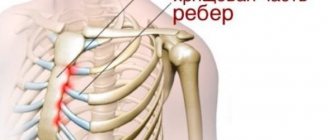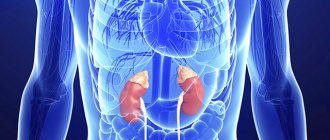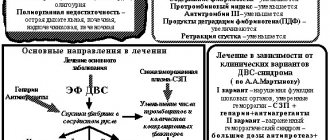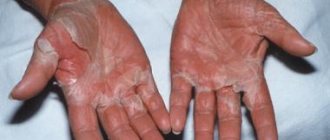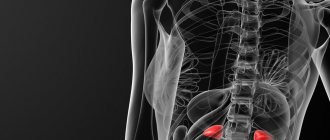There is primary and secondary polycystic disease. If the primary form of the disease is determined at the genetic level and may first appear during puberty, then secondary polycystic disease is a symbiosis of a number of symptoms. That is why it is often referred to by the abbreviation “PCOS,” which means “polycystic ovary syndrome.”
Some researchers argue that a name such as “polycystic ovary syndrome” does not sound entirely correct, and a more correct formulation would be “polycystic ovary syndrome.” In the latter case, we can talk about some secondary pathologies and changes, while polycystic ovary syndrome itself implies a primary disease.
The shape of the ovary is somewhat similar to a peach pit - dense with an uneven surface. The ovarian membrane consists of protein; it is here that the follicles are contained, along with the maturation of which the maturation of the egg itself occurs. The follicles burst during the period when ovulation occurs, after which an egg is released from the ovary.
In cases where ovarian function is impaired for some reason, we can talk about hormonal changes. The disease itself looks like the formation of cystic formations. There are quite a lot of them, and these neoplasms begin to affect the tunica albuginea of the ovaries. As a rule, the menstrual cycle begins to loosen and various disturbances occur. One of the consequences of polycystic disease is infertility in women. Experts have reliably established through research that the diagnosis of polycystic ovary syndrome can be made based on two main signs - this is, first of all, menstrual irregularities and hyperandrogenism, which includes the occurrence of acne, hair growth, and an increased amount of androgens in the blood. It is on the basis of hyperandrogenism that the diagnosis of this disease is mainly established.
If we consider the two forms of polycystic ovary syndrome, we can note the following changes. Thus, primary polycystic disease usually develops in girls under 12 years of age, while the amount of insulin in the blood does not increase. The disease also does not affect body weight. This type of polycystic ovary syndrome is quite difficult to treat surgically.
As for secondary polycystic ovary syndrome, the symptoms are somewhat different. Most often, it is observed in adult women, accompanied by increased insulin levels and weight gain. Often, PCOS can also occur in a woman who is in the menopause phase. This form of polycystic disease is much easier to treat, and doctors often use traditional methods for this.
The doctor must distinguish between polycystic ovary syndrome and polycystic ovary syndrome. According to statistics, no more than 10% of women around the world are diagnosed with polycystic ovary syndrome, but it is the main cause of disorders of the reproductive function of the body.
Causes of polycystic ovary syndrome
At the moment, the causes of PCOS have not been precisely established. But one way or another, they are associated with hormonal imbalance (as a result of a serious infection, nervous disorders, and even climate change).
Possible causes of the disease:
- Disturbances in the functioning of the hypothalamus and pituitary gland - areas of the brain that regulate the production of hormones. The functioning of the adrenal glands and ovaries, the synthesis of luteinizing (LH) and follicle-stimulating (FSH) hormones, which affect the maturation of the egg and its release from the follicle, depend on them. Improper functioning of these organs leads to an imbalance: the level of luteinizing hormone increases, as a result, the woman’s body produces more male hormones.
- Disturbances in the functioning of the adrenal glands themselves.
- Improper functioning of the ovaries, including as a result of inflammation of the appendages.
- Improper functioning of the pancreas, which results in insulin resistance. Excess insulin leads to increased production of LH. It is insulin resistance that causes excess weight accumulation and obesity in women with polycystic disease (this symptom occurs in approximately 40% of patients).
Consequences of the syndrome
It is important to treat the disease even if it does not cause discomfort. Women with PCOS during menopause need to be closely monitored by specialists. The disease carries with it threatening complications, this is what PCOS threatens with:
- diabetes mellitus (statistics show that about 50% of women diagnosed with PCOS have type 2 diabetes by the time of menopause);
- high testosterone leads to better absorption of so-called bad cholesterol, resulting in an increased risk of cardiovascular disease;
- sclerocystic disease and polycystic transformation lead to a lack of ovulation, resulting in prolonged growth of the endometrium, which threatens the appearance of atypical cells and degeneration into cancer.
The main and most unpleasant consequence of PCOS for young women is infertility.
Symptoms
Even with primary polycystic disease, the first menstruation in girls can begin on time. But after two or more years, the cycle remains irregular, menstruation is absent for several months. Women of reproductive age also have irregular periods or no periods at all. Rare menstrual bleeding is often accompanied by pain and heavy uterine bleeding, which occurs due to excessive growth of the endometrium.
Symptoms of polycystic disease:
- Irregular cycles or absence of menstruation (amenorrhea);
- Obesity. The condition when fat accumulates only in the abdominal area is more severe and dangerous than in patients with even distribution of fat.
- Excessive sebum production, acne.
- Excessive hair growth, hair can grow in the mammary glands.
- Male pattern baldness.
- Body temperature is elevated throughout the entire monthly cycle.
- Nagging pain in the lower abdomen.
- Inability to conceive or constant miscarriages.
Signs of polycystic ovary syndrome
If a girl has a late onset of menstruation, an irregular cycle, a male body type, excessive thinness or obesity, the gynecologist may assume the presence of primary polycystic ovary syndrome and prescribe additional examination.
A gynecologist can make a diagnosis of “polycystic ovary syndrome” if the patient has at least two of three signs:
- Ovarian dysfunction is observed, which is indicated by the absence of ovulation, menstruation, and prolonged infertility.
- Increased production of male sex hormones (this is indicated by excess hair growth, activity of the sebaceous glands).
- Changes in the size and structure of the ovaries, confirmed by ultrasound and diagnostic laparoscopy.
Complications of the disease
Polycystic ovary syndrome is a dangerous disease that can lead to complications if not treated correctly. Among them:
- infertility;
- severe obesity;
- dyslipidemia i.e. violation of fat metabolism;
- development of type II diabetes mellitus due to tissue resistance to insulin produced by the pancreas;
- oncological changes in the endometrium of the uterus;
- breast cancer;
- pathological changes in the blood coagulation system, up to a tendency to increased thrombus formation;
- atherosclerotic vascular lesions;
- pathologies of the cardiovascular system.
Due to the large number of complications that PCOS can cause, treating it independently, without the supervision of a specialist, is strictly not recommended. The use of folk remedies in the treatment of the disease is also not recommended.
Diagnostics
A presumptive diagnosis of PCOS is made if a woman has problems conceiving, irregular or absent menstruation, and there are signs of excess male sex hormones. However, such a picture can occur in the presence of tumors, disturbances in the structure and functioning of the pituitary gland or adrenal glands, hyperprolactinemia (excessive production of the hormone prolactin. Normally, it increases during breastfeeding, but in women with disorders of the pituitary gland and adrenal glands, there is an increased production of this hormone and lactation occurs , which has nothing to do with childbirth.To clarify the diagnosis, a comprehensive examination is necessary.
Diagnostic methods used to confirm the diagnosis:
- A general examination, during which excessive hair growth or baldness, the presence of acne, seborrhea and other signs indicating increased production of male sex hormones are confirmed.
- Examination on a gynecological chair, during which the doctor confirms changes in the structure of the ovaries, their enlargement.
- Blood test for female sex hormones - estrogen, prolactin, FSH, LH.
- Blood test for male sex hormones - testosterone, androstenedione, dehydroepiandrosterone sulfate.
- Blood test for cortisol (stress hormone).
- Blood test for sugar, insulin, TSH.
- Ultrasound examination of the ovaries, which will determine the degree of enlargement of the ovaries, the number and size of cysts, changes in the structure of the ovaries.
- Doppler measurements of ovarian vessels to assess the intensity of their blood supply.
- Magnetic resonance imaging of the ovaries - to exclude the possibility of tumors.
- If you suspect a tumor of the pituitary gland or hypothalamus, you should also undergo an MRI of the brain with contrast.
- Blood test for lipids.
- Diagnostic laparoscopy.
Together, all studies will help the attending physician confirm the diagnosis and develop the most effective treatment tactics.
To determine the type of polycystic disease, use:
- Test with dexamethasone: its use reduces the production of adrenocorticotropic hormone (ACTH). In primary polycystic disease, ACTH synthesis decreases slightly. In secondary, especially adrenogenital syndrome, the level of male sex hormones decreases sharply.
- Test with adrenocorticotropic hormone. After its introduction into the body, in primary polycystic disease the level of male hormones increases slightly; in secondary polycystic disease, it increases sharply.
What specialists may additionally need help to diagnose and treat the disease?
Women with polycystic disease are examined and treated by a gynecologist or gynecologist-endocrinologist. You may also need advice:
- endocrinologist (especially if you have diabetes);
- surgeon (if surgery is required);
- a neurosurgeon (if there is a suspicion that a hormone imbalance is caused by formations in the pituitary gland and hypothalamus).
How to confirm the diagnosis
To verify the truth of the disease, it is necessary to evaluate the overall clinical picture. Some hormonal and gynecological pathologies have similar symptoms, so to confirm the diagnosis it is necessary to consider:
- woman's complaints;
- results of gynecological examination;
- ultrasound diagnostics;
- blood analysis.
There are several ways to make sure that you are not ovulating: measuring your basal temperature, performing folliculometry, using home tests, or monitoring your vaginal discharge.
Treatment
Therapy for this disease is aimed at stimulating and normalizing ovulation and the menstrual cycle, adjusting hormone levels.
Treatment methods
As part of the treatment of patients with polycystic ovary syndrome, the following activities are carried out:
- Stimulating ovulation and normalizing the monthly cycle in order to increase the chances of conception and a successful pregnancy outcome;
- Decrease in the level of male sex hormones;
- Normalization of weight.
In most cases, conservative treatment is prescribed. If it does not give effect, surgical methods are used.
Additional amounts of male sex hormones are often synthesized in fat deposits. Therefore, for some patients, it is enough to lose 10-20 kilograms in order for their hormones to more or less come into order. After losing weight, the monthly cycle normalizes and ovulation appears. In the future, weight normalization allows you to completely get rid of PCOS without resorting to radical methods. This happens if the body does not have serious endocrine and metabolic disorders that require additional treatment.
Conservative therapy
The most common treatment option is hormone therapy. The woman is prescribed oral contraceptives, which help level out hormone levels and “reboot” the ovaries. A specific drug is prescribed by a gynecologist, based on the results of a blood test for hormones. Oral contraceptives help reduce the level of male hormones; after stopping them, many patients manage to get pregnant.
Surgery
If conservative treatment does not produce results, the patient’s condition does not improve, endometrial proliferation is confirmed, or the patient is planning a pregnancy in the near future, the doctor recommends surgical intervention - wedge resection of the ovaries. During the operation, the most affected part of the ovary is removed, and the cut site is cauterized. The operation is performed laparoscopically, which speeds up the recovery period and reduces the risk of complications.
Several small incisions are made in the abdomen, through which a video camera and special instruments are inserted. This technique does not allow large blood loss and allows you to return to normal life within a few days. There is also no need to undergo a course of antibiotic therapy to prevent wound infection.
Wedge-shaped resection of the ovaries stimulates their activity, normalizes ovulation and the monthly cycle, increases the production of female hormones and reduces the synthesis of male ones. Additionally, after the operation, the patient is prescribed hormonal drugs to stimulate ovulation.
The effect of such treatment is not eternal: it lasts a maximum of three years, then the manifestations of the disease return. The first operation is the most effective, with each subsequent operation the effect decreases. Therefore, doctors advise getting pregnant six months after the first wedge resection. During this period, approximately 65% of patients can become pregnant and bear a healthy child.
If pregnancy does not occur after surgery, the patient should undergo testing for tubal patency.
Excessive growth of the endometrium can also be an indication for surgery.
If polycystic ovary syndrome has developed against the background of dysfunction of the adrenal glands and pituitary gland, wedge resection is not used: in this case it is ineffective.
If the cysts rupture or after several wedge-shaped resections, as well as if there is a risk of oncological pathology, the ovaries are removed completely.
Diet
Since women with polycystic ovary syndrome are often prone to obesity, physical activity and dietary modification are recommended. Lifting weights and intense training should be limited so as not to provoke cyst rupture, but moderate sports, walking, and static loads are quite acceptable. At the same time, such patients should not fast for medicinal purposes, since due to lipid metabolism disorders, proteins begin to be burned, not fats.
How to eat healthy if you have polycystic ovary syndrome:
- Limit the amount of food high in carbohydrates (flour, baked goods, sweets, sugary drinks);
- Increase the amount of lean protein foods and fiber;
- Eat more vegetables and unsweetened fruits;
- The limit on fat consumption is no more than 80 g per day, including hidden fat, and it is better to replace animals with vegetable ones;
- More low-calorie foods (greens, fiber-rich vegetables, fruits);
- Eat little but often: 5-6 times a day;
- Reduce the calorie content of the area to 1200-1800 kcal per day;
- Arrange fasting days at least 1-2 times a week (eat only low-fat dairy products, vegetable or fruit days);
- Stop drinking alcohol and smoking - they increase hormonal imbalance and increase the risk of cancer;
- Avoid salty, smoked foods, industrial sauces and semi-finished products;
- Refuse yeast baked goods and white bread in favor of whole grain bread;
- Control your coffee and tea consumption: excess caffeine can cause an increase in cortisol and male sex hormones.
It is important for women with polycystic disease to avoid stress and nervous tension, get more rest, sleep at least 7 hours a day and spend more time in the fresh air.
Classification
Polycystic ovary syndrome is a disease that has a small classification. It is based on where the pathology originated from. Highlight:
Primary disease
This group includes, first of all, the congenital form of polycystic disease. It occurs due to various disorders that appear at the stage of fetal development in the womb. Additionally, this also includes a disease in which structural disorders in the organ are primary, but endocrine disorders are already of secondary origin. This situation is rare.
Secondary disease
Polycystic disease is called secondary if it develops against the background of pre-existing endocrine disorders. In clinical practice, the secondary form of polycystic ovary syndrome occurs more often than the primary one (95% of cases).
Prevention of polycystic disease
There are no universal rules yet that would completely prevent the development of this disease. But a healthy lifestyle and proper nutrition can significantly alleviate both the course of the disease and its consequences.
If you are overweight, you must definitely get rid of it and review your diet, eliminate animal fats, and eat low-calorie foods. This scheme will have to be followed constantly.
Hormonal imbalance can occur due to chronic infections and stress. To prevent this, it is necessary to treat inflammatory diseases (especially the female genital area) in a timely manner. Diseases of the nervous system should also be kept under control, combat increased nervousness and avoid stressful situations.
Laparascopic examination
During laparoscopy, special instruments are inserted through the abdominal cavity. This method is usually used to establish a differential diagnosis and simultaneous treatment of various forms of infertility.
Characteristic signs of the disease are enlarged ovaries, their surface resembles tubercles, and the capsule has a pearl color. If necessary, treatment is carried out immediately.
Important! This method has minimal consequences, but maximum effect. Moreover, it is not painful at all.
